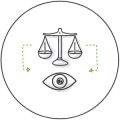Curriculum
How are the rights of the accused upheld during trial procedures in accordance with the Canadian Charter of Rights and Freedoms?
- I can identify the legal rights in the Canadian Charter of Rights and Freedoms and discuss their importance.
- I can present examples of how Canadian Charter of Rights and Freedoms protects the rights of accused persons.
- I can reflect on my own misconceptions and biases regarding the rights and treatment of accused persons in court.
How have principles of law and justice changed over time and how do they differ today in different legal systems?
- I can debate the merits of different legal systems by using persuasive language and examples.
- I can analyze early legal systems to identify key principles and commonalities.
- I can collaborate to construct a comprehensive argument.
What have been the turning points for women’s rights in Canada?
- I can identify Canadian women who were trailblazers for women’s rights.
- I can analyze significant turning points in women’s rights in Canada.
- I can explain what needs to be done to remove barriers to gender equality in Canada today.
What is the contribution of the labour movement in achieving many social programs, policies, and laws in Canada?
- I can name benefits that we enjoy today because of the labour movement.
- I can analyze the causes and consequences of milestones in workers’ rights.
- I can consider my personal opinions about unions and workers’ rights.
What is justice?
- I can discuss the major issues around fairness and justice in creating laws for a society.
- I can analyze the tensions between two visions of a society and their benefits and deficits.
- I can consider the criteria for the concepts of fair, equal, and just in the context of public life.
How does the Indian Act promote assimilation?
- I can describe the worldview of the Canadian government that resulted in the Indian Act.
- I can analyze three main sections of the Indian Act: the reserve system, residential schools, and Indian status.
- I can recognize the long-term consequences of assimilationist policies and legislation on the First Peoples of Canada.
How can understanding implicit bias and systemic racism help us address racial injustices?
- I am able to define implicit bias and systemic racism.
- I can analyze the significance of legislation and policies and determine their impact on historical and contemporary racial inequality.
- I can explain why it is necessary to raise awareness of racism in Canada and to take action for justice.
What is the contribution of the labour movement in achieving many social programs, policies, and laws in Canada?
- I can name benefits that we enjoy today because of the labour movement.
- I can analyze the causes and consequences of milestones in workers’ rights.
- I can consider my personal opinions about unions and workers’ rights.
How do a country’s laws and policies reflect its values?
- I can summarize how Canadian immigration policies have changed over time.
- I can explain the importance of the Komagata Maru Incident and its significance in Canadian history
- I can consider how our laws and policies reflect our values.
Should we abolish the Indian Act?
- I can describe the worldview of the Canadian government that resulted in the Indian Act.
- I can analyze three main sections of the Indian Act: the reserve system, residential schools, and Indian status.
- I can consider perspectives for and against abolishing the Indian Act.










